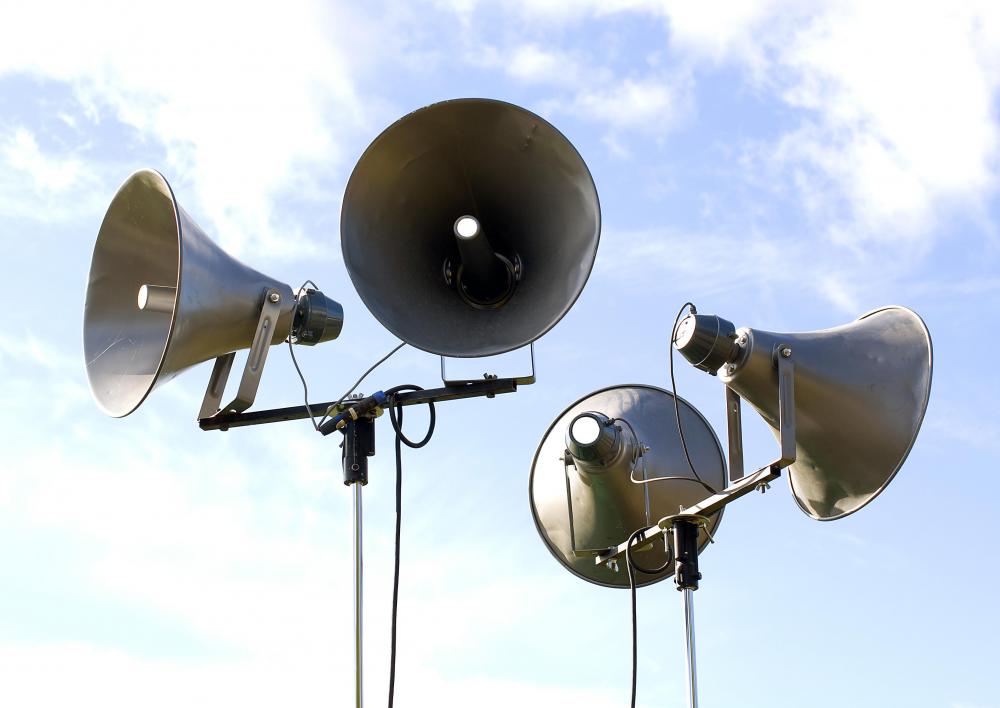At EasyTechJunkie, we're committed to delivering accurate, trustworthy information. Our expert-authored content is rigorously fact-checked and sourced from credible authorities. Discover how we uphold the highest standards in providing you with reliable knowledge.
What are the Different Types of Antenna Designs?
Antennas come in a great many sizes, shapes, and functions, and much of their core design is driven by what exactly it is they’re meant to do. Radio signal receivers are often single metal casings known as monopoles, while those used for broadcast television are often branched or forked. Antennas intended to pick up cable, satellite, and global positioning system (GPS) signals are usually shaped differently, often as a dish or movable metal patch, and antennas whose main purpose is signal amplification sometimes look like horns or cones. Some very small antennas are used to track things like merchandise in stores; these are usually no more than tiny strips, many of which are intended to be disposable. Overall design usually depends a lot on what sorts of signals the devices are meant to receive, as well as where and how they’re intended to be used.
Understanding Basic Form and Function

The basic idea behind any antenna is to interpret and translate a signal that is generated from some other device or service positioned at some distance away. These signals usually come in the form of electromagnetic waves. The design is usually specifically optimized to receive a certain spectrum of waves. This is one of the main reasons antennas only pick up the signals for which they’re designed — for example, ordinary car antennas typically only pick up basic AM/FM band radio, not cell phone receptions, television signals, or radio on non-standard bands.
Monopole Antennas

Monopole antennas are the most common and tend to be simplest of all antenna designs. They usually consist of a single antenna, often one that can be retracted. The antennas that come on most cars for radio reception are common examples. In these cases, the owners don’t really have to do much to get them to work and may not even realize that they’re present. Tuning the dial on the car’s sound system is usually all that’s needed to trigger a signal shift along the shaft that tells the antenna to start interpreting and channeling a different frequency.

The whip antenna used for Citizens Band (CB) radio applications is another example in this category. These tend to be portable and extendable, and operators may have to program them manually. Once set up, though, they work a lot like a standard car radio antenna.
Dipole Examples
Dipoles are also popular antenna designs. These typically consist of two wires that are pointed in opposite directions and can be arranged vertically or horizontally. One end of each wire usually is connected to a radio while the other end is allowed to hang freely. The dipole design is most commonly associated with the V-shaped “rabbit ears” or “bunny ears” used to help improve television reception.
Other Common Television Receptors

Television reception can be a tricky thing, particularly in dense urban areas or remote locations where signals have to travel great distances or around land masses like hills and mountains. Another one of the most common antenna designs associated with television reception is Yagi-Uda antennas, also known as directional or beam antennas. These usually consist of an array of dipole shafts and reflectors that help to focus the signal for better reception. Most are mounted on or otherwise attached to a roof, and they’re are also frequently used by amateur ham radio operators.
The parabolic design, also known as a “dish antenna,” is commonly mounted on rooftops or in yards to channel and filter satellite TV reception. These devices can also increasingly channel digital signals. Parabolic antennas fit into this category, too. These are high-gain reflectors that can be used for radio, data communications, and radar applications.
Horn Models
Horn antennas are often used for transmitting high-gain, high-frequency sounds. These usually look a lot like bullhorns and are mounted in regions where they can easily receive and then amplify signals. Some of the most common examples include megaphones and speakers used for live sound systems. They also are used in ultra high frequency reception.
Temporary and Portable Designs
A random wire, or zig-zag, antenna typically is a simple wire that is hung with one end connected to a ground wire and a radio. The wire is then arranged in a way that promotes the best reception or transmission, such as being strung between two trees. Random wire is commonly used for temporary reception or transmission of long-, medium-, or short-wave bands, and is popular with many military operations.
Patch antennas, also known as microstrip antennas, consist of a single metal patch suspended over a ground plane. Their highly portable design allows for use with GPS, and they are often installed on the inside of many mobile phones. When users want to access GPS coordinates, this part of the phone activates and the antenna sends out a signal.
Identification Tags
Other small antenna are also used in what’s known as radio frequency identification (RFID) technology, which is increasingly popular in business all over the world. Clothing items can be tagged with these tiny devices in order to help retail stores keep track of what’s in stock, for instance, and they can be implanted on almost anything in order to track it in real time. These antennas are usually made quickly and inexpensively, and aren’t intended for a long life. People who purchase tagged goods are usually instructed to simply snip the ID patch out and through it away. In most cases they only work within a short radius of the home system.
AS FEATURED ON:
AS FEATURED ON:














Discuss this Article
Post your comments